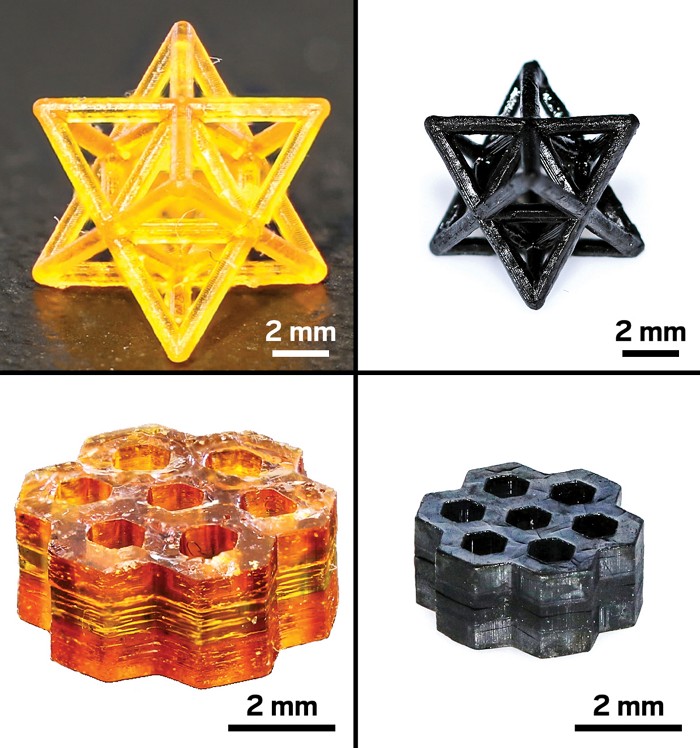
Credit: Science
Polymer precursors (light colors) were 3-D printed in complex shapes and converted to ceramics in just seconds (black). The honeycomb structure contains uniquely doped layers (bottom left) and functions as a magnetic sensor.
An ultrafast method can drastically reduce the time needed to synthesize ceramics, cutting prep time from several hours to less than a minute (Science 2020, DOI: 10.1126/science.aaz7681). The high-temperature technique, which works with many classes of ceramics, can be used for manufacturing and for high-throughput evaluation of novel materials.
Ceramics have long played key roles in electronics, energy storage, and extreme temperature applications because of the materials’ thermal, mechanical, and chemical stability. Chemists often make ceramics by combining powdered precursors and heating the mixture for hours in a furnace. The heat drives solid-state reactions that fuse the particles into a solid product through a process known as sintering.
This prolonged exposure to high temperatures not only means ceramics production is slow, it also can cause volatile elements to diffuse and escape from the reaction mixture. That unwanted process is hard to control and may adversely affect product properties. For example, some garnet-type ceramics are being studied for use as solid-state electrolytes, which are fire-resistant alternatives to the flammable liquid electrolytes used in lithium-ion batteries. But it’s difficult to make them reliably. These materials can lose lithium during sintering, which can reduce their ionic conductivity and impair battery performance.
To shave time off the lengthy ceramics production procedure, researchers have devised various rapid-processing methods, such as flash sintering and microwave-assisted and spark-plasma sintering. But those methods can be expensive or limited in terms of the temperatures they can reach or the types of ceramics to which they can be applied.
Aiming to bypass those limitations, a large team of researchers including the University of Maryland’s Chengwei Wang, Liangbing Hu, and Yifei Mo came up with a simple way to make numerous types of ceramics in seconds. The team presses pellets of mixed precursor powders, then inserts the pellets between carbon strips that are heated electrically in an inert atmosphere, reaching up to 3,000 °C in less than 30 s. Holding the starting material at high temperature for about 10 s drives reactive sintering.
The team used the pellet-heating method to make many types of ceramics, including a set of Li-ion-conducting La-Zr-Ta garnet-type electrolytes with various amounts of lithium. Mass spectrometry shows that lithium loss in samples made via the ultrafast method did not exceed 4% because the light element had little time to diffuse. In contrast, that number reached 99% in some control samples made over several hours in a conventional furnace.
The team also demonstrated that the new method isn’t limited to processing flat pellets. They used it to prepare centimeter-sized ceramic objects of various complex shapes by rapidly heating polymer-based precursor structures that were built via 3-D printing. One of the structures, a piezoresistance magnetic field sensor, contains Al–doped layers for piezoresistivity and separate co-doped regions for magnetic response. Analyses show that the sensor works well because the metal dopants remained in place during fast processing. By contrast, high levels of diffusion caused the control device to work poorly.
“Being able to sinter a material in 10 seconds is a game changer,” says Gerbrand Ceder of the University of California, Berkeley. Ceder, a pioneer in combining computational and experimental methods to discover new battery materials, expects that the study will have an impact in the area of solid-state batteries, making manufacturing with high-throughput more likely. The advance may also enable speedy evaluation of predicted novel materials, he says.
“Today, in materials design, we are often limited by the slow speed by which predictions can be experimentally validated or negated. Rapid synthesis methods, like the one described here, may change that.”
Chemical & Engineering News
ISSN 0009-2347
Copyright © 2020 American Chemical Society
"Flash" - Google News
May 06, 2020 at 04:08AM
https://ift.tt/35xR1h0
Making ceramics in a flash - Chemical & Engineering News
"Flash" - Google News
https://ift.tt/39L7UpV
Shoes Man Tutorial
Pos News Update
Meme Update
Korean Entertainment News
Japan News Update
Bagikan Berita Ini















0 Response to "Making ceramics in a flash - Chemical & Engineering News"
Post a Comment